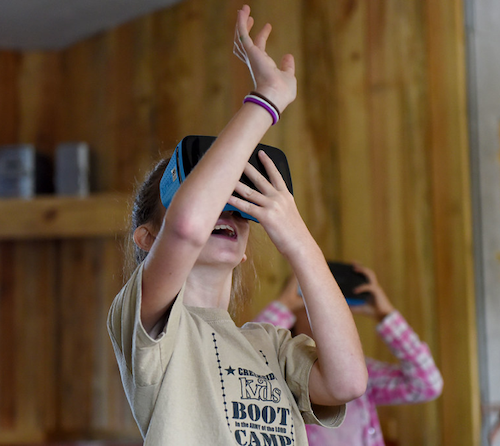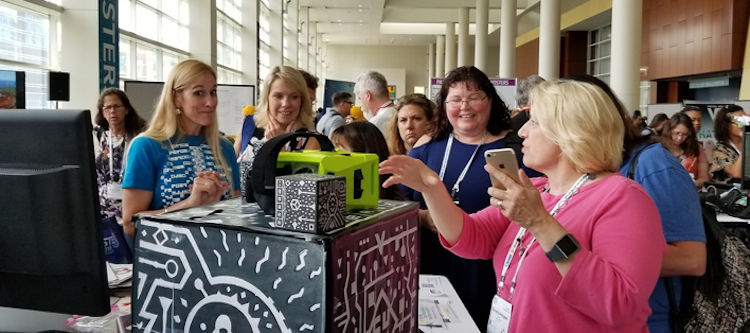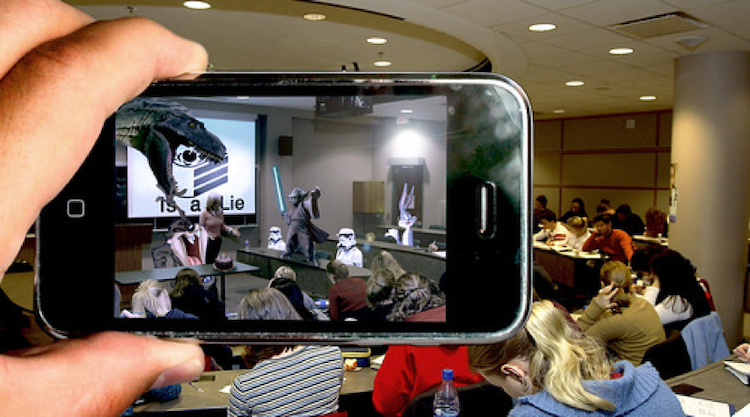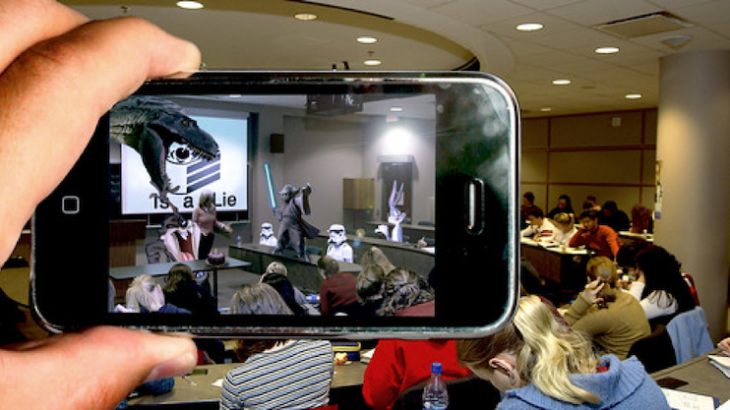Jasleen Grewal, Communications, Education and Outreach co-editor
“Melissa Kaplan begins her junior high school day on 4/4/2020 by rolling out of bed and donning her Ultralite TM glasses and gloves. […] she picks up a virtual microscope and dissection instrument […]. A little squeamish, Melissa needs some reassurance and instructions from her Virtual Teacher before she begins to examine the human heart ”
– Joseph Psotka, 1995, in ‘Immersive training systems: Virtual reality and education and training’. Instructional Science 23: 405–431

Virtual and augmented reality technologies are becoming a mainstay in our lives. How are Canadian classrooms using these immersive teaching aids? Image courtesy of the S.C. Air National Guard
As fictional writing goes, this 1995 commentary on the future of education has managed to land in the ballpark of prophecy. April 4th, 2020, is not far away, and virtual dissection is already a reality.
Since the late-1980s, virtual reality (VR) has been used to train pilots (flight simulators), doctors (surgery simulations), and astronauts for working in zero-gravity environments. With the advent of consumer VR devices, technology-savvy teachers have been quick to add virtual and augmented reality (VR/AR) platforms to their teaching toolkits. Canadian schools have steadily adapted VR for classroom education, typically through provincial initiatives or industry sponsorship.
Several school districts in British Columbia are using VR technology to encourage collaborative problem-solving and interactive learning. In these classrooms, VR is not just about introducing exploratory, immersive reality experiences but provides innovative approaches to teaching. Mike Page and Nate Lott, two teachers in British Columbia, have developed new curricula for various grade levels using VR/AR development platforms. Besides providing seminars and encouraging fellow teachers to modernize their students’ learning, they routinely use VR/AR in their own classrooms.
Page and Lott’s approach highlights a crucial aspect of integrating VR into classroom education. The VR/AR platforms are used for skill building and evaluation in the classroom. The students spend about 95 per cent of class time working on the computer (individually or as groups) designing VR spaces and showcasing learning outcomes and only 5 per cent of their time wearing the headsets. For example, after drawing in students with the initial excitement of VR games, educators can motivate them to develop their own games while showcasing learning outcomes from taught curriculum. Educators can also leverage other strategies for interactive group activities, such as writing AR/VR-based book reviews or using dome theatres.
The availability of coding platforms like Tinkercad and Poly lets students at every grade level take charge of their VR experience, adding a sense of ownership to the resulting work. Platforms like CoSpaces and Scratch allow students to set up 3D scenarios and programmatically control the interaction of various objects.
In Page and Lott’s opinion, “outsiders see it as ‘gaming’ when they probably haven’t experienced the creation of VR/AR.”
This is a critical point. Content development and delivery of VR based learning systems is a key aspect of VR-based education. Dr. Elisabeth Ormandy is the Executive Director of the non-profit Animals in Science Policy Institute, which seeks to use VR dissections as an alternative to animal dissections in British Columbia’s schools. According to her, a crucial element of change has been involving teachers in the process of VR resource development. Doing so has improved the quality of content being developed, while bringing teachers up to speed with various classroom settings that can benefit from the use of VR/AR.
Page and Lott agree – in their experience, most teachers are willing to give VR education tools a try, but the learning curve can be steep for many and a lot of them may want to stop “as the students start to know more than them pretty quickly.” Teachers are encouraged to embrace this role-reversal and allow their students to teach them. As Page and Lott point out, “The mindset needs to change from standing in front of the room with all the answers to working beside the kids.”
Online resources developed by fellow teachers can help ease the transition to VR/AR based education. Page and Lott jointly manage a public website housing AR/VR curricula and educator resources they’ve developed and tested.While the wide array of available programs can feel intimidating (even to technology enthusiasts!), Page suggests the strategy of ‘going with the goers’ – working towards the goal of feeling comfortable while learning new tools – can go a long way if you have an open mindset.
Educator training can also jumpstart teachers and lay the groundwork for classroom-ready projects like Clevr by MIT. Freely accessible resources like Google Expeditions and Discovery VR, among others, and open-source projects by non-profits like eCampus-Ontario’s VR sandbox are a step towards this.
Several companies are also realising the value of having a VR education research arm, making VR content development a booming area. Earlier this year, Microsoft announced a partnership with VictoryVR, a VR curriculum development company, to create STEM-based VR field trips and learning experiences for students in grades 5–12 (headset purchase required).
Other teacher education opportunities include teacher conferences like International Society for Technology in Education (ISTE) and organizing professional development days that focus on VR/AR technologies. The need to start these conversations extends both ways. As Ormandy points out, part of the advocacy for VR in education includes asking teachers what they need rather than simply developing materials that the tech industry thinks they want.

Attendees at ISTE 2018 marvel at a big MERGE cube display. Interactive technologies like these open up an augmented reality portal through one’s phone or VR headset, accompanied by several open-source mobile apps that assist knowledge translation and discovery. Conferences like ISTE provide teachers and content developers a platform to keep up-to-date about emerging technologies in education. Image courtesy of center4edupunx, at Flickr, CC BY-NC-SA 2.0
But how do educators bring VR/AR into their classrooms without putting an immense hole in the school budget? Open-source tools and resources can help teachers with this. Educational AR toys like MERGE Cube can be used with a cell-phone camera and can be built from scratch using some paper, a printer, and some tape. Google Cardboard or the BeThere book can be mocked up into headsets from cardboard pieces.
Local communities can also take the initiative to support under-funded schools in their VR quest by providing the raw materials for do-it-yourself VR – like refurbished phones for students in need, or computers and iPads that can be shared by groups of students.
It is worth keeping in mind that, as Ormandy puts it, “good educators cannot rely on their tools to be a good educator.” The onus is on the teachers to best leverage available resources and technologies that enrich their students’ learning experience, and technology is never a substitute for good teaching practices. Still, the potential benefits are enticing.
While the education outcomes from using VR in classrooms remain to be seen, the integration of technology in the classroom is steadily gaining traction as an essential requirement in education systems. In its 50-year Global Competencies plan, the Council of Ministers of Education, Canada emphasizes the utility and need for technology in developing student-centered, authentic learning environments.

“Your eyes can deceive you. Don’t trust them.” Obi-Wan Kenobi’s words have never rung truer; Image courtesy of turkletom CC BY 2.0.
Technology-based education frameworks help build core competencies, and enable the students to develop innovative, problem-solving strategies and create new knowledge. Many of the jobs that today’s school-children will hold as adults have not been invented yet, and it is our responsibility as communicators and educators to ensure we equip kids with the skills they will need in the future. VR/AR is one way to make that happen.
~30~




